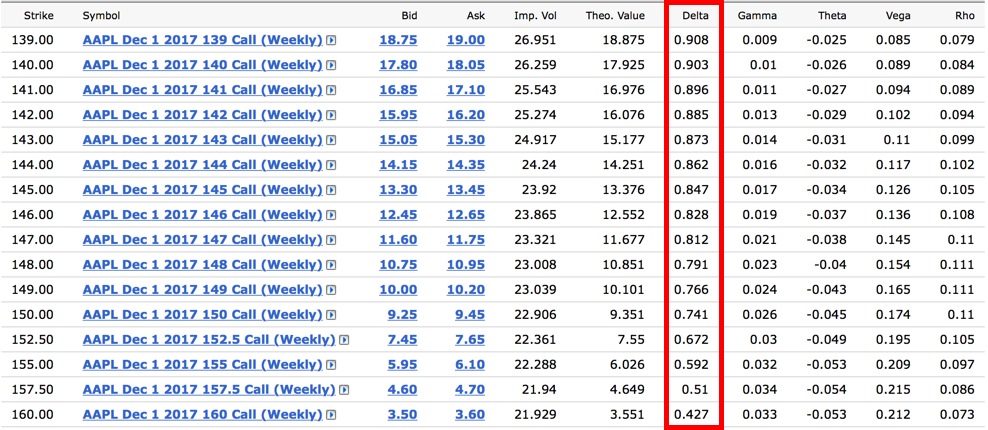Delta is the most commonly used and easiest to understand of the Greeks, which measures the rate of change of an option price given a $1.00 increase in the price of the underlying asset. The value of a Delta is influenced by the time remaining until expiration and the strike price of the option relative to the underlying price of the asset.
For example, the table below shows AAPL options that expire in three months assuming a $157.44 current price. The in-the-money option with a $139.00 strike price has a 0.908 Delta, which means that the price will rise about $0.91 for every $1.00 increase in AAPL’s price. However, the out-of-the-money call with a $160.00 strike price has a 0.427 Delta, which means that it will increase just $0.43 per $1.00 increase in AAPL’s price.

Option Price vs. Asset Price
A good way to conceptualize Deltas is to think of a race track, where the tires represent the Delta and the gas petal represents the underlying price. Low Delta options are like race cars with economy tires in that they won’t get a lot of traction when you rapidly accelerate. On the other hand, high Delta options are like drag racing tires that provide a lot of traction when you step on the gas. Delta values closer to 1.0 or -1.0 provide the highest levels of traction.
For example, suppose that one out-of-the-money option has a Delta of 0.25 and another in-the-money option has a Delta of 0.80. A $1.00 increase in the price of the underlying stock will lead to a $0.25 increase in the first option and a $0.80 increase in the second option. Traders looking for the greatest traction may want to consider high Deltas, although these options tend to be more expensive in terms of their cost basis since they’re likely to expire in-the-money.
Probability of Being In-the-Money
The Delta is commonly used when determining the likelihood of an option being in-the-money at expiration. For example, an out-of-the-money call option with a 0.20 Delta has roughly a 20% chance of being in-the-money at expiration where as a deep in-the-money call option with a 0.95 Delta has a roughly 95% chance of being in-the-money at expiration. The assumption is that the prices follow a log normal distribution (e.g. like a coin flip).
On a high level, this means that traders can use Delta to measure how risky a given option or strategy is. Higher Deltas may be suitable for high-risk, high-reward strategies with low win rates, while lower Deltas may be ideally suited for low-risk strategies with high win rates.
Directional Risk Assessment
The Delta is also used when determining directional risk. Positive Deltas are long market assumptions, negative Deltas are short market assumptions, and neutral Deltas are neutral market assumptions. When you buy a call option, you want a positive Delta since the price will increase along with the underlying asset price. When you buy a put option, you want a negative Delta where the price will decrease if the underlying asset price increases.
Traders may use these assumptions when building strategies. For example, a trader implementing a neutral option strategy (such as a calendar spread) may try to minimize the position Delta. The table below shows the desired position Delta for a variety of different option strategies, which can help traders when trying to find opportunities.
|
Strategies |
Position Delta |
|
Long Call |
Positive |
|
Short Call |
Negative |
|
Long Put |
Negative |
|
Short Put |
Positive |
|
Long Straddle |
Neutral |
|
Short Straddle |
Neutral |
|
Long Strangle |
Neutral |
|
Short Strangle |
Neutral |
|
Put Credit Spread |
Positive |
|
Put Debit Spread |
Negative |
|
Call Credit Spread |
Negative |
|
Call Debit Spread |
Positive |
|
Call Ratio Spread |
Negative |
|
Put Ratio Spread |
Positive |
|
Call Back Spread |
Positive |
|
Put Back Spread |
Negative |
|
Calendar Spread |
(Near) Neutral |
|
Covered Call Write |
Negative |
|
Covered Put Write |
Positive |
Hedging a Position
The term Delta applies to both financial assets and their options, although the actual assets have an absolute Delta of 1.0 since they move dollar-for-dollar with themselves. For example, an investor holding 100 shares of stock has 100 Delta in their portfolio.
The investor may want to hedge the portfolio against such a long bias if they think that the stock could experience a consolidation ahead. In this case, they may decide to write covered call options that provide a negative Delta (see table above). A -30 Delta from these covered call options could reduce the overall portfolio Delta to 170. Of course, Delta changes over time, so the hedge may not cover the same amount of risk over time.
The Bottom Line
Delta is helpful when determining how an option’s price will react to changes in the underlying stock. These dynamics can prove useful when estimating the likelihood of an option to be in-the-money at expiration, calculating how to hedge a portfolio, or simply understanding what options are likely to benefit the most from a move in the underlying asset price.
Options Greeks: Vega Risk and Reward
-
 Retirement
RetirementIs Delta Stock Suitable for Your IRA or Roth IRA? (DAL)
Learn about Delta Airlines and the factors that affect the company's performance. Discover if Delta stock makes an appropriate investment for IRA accounts. -
 Trading
TradingUsing the "Greeks" to Understand Options
The Greeks provide a way to measure the sensitivity of an option's price to quantifiable factors. -
 Insights
InsightsDelta Releases Q4 & 2016 Revenue Figures (DAL)
Delta’s revenue figures for Q4 and 2016 are down from the previous year, mostly due to declines in passenger revenue. -
 Trading
TradingOption Greeks: The 4 Factors to Measuring Risks
In this article, we'll look at Greek risk measures: delta, theta, vega, gamma and explain their importance that will help you better understand the Greeks. -
 Insights
InsightsDelta to Revamp Business Class; Expand Codeshare With Korean Air (DAL)
Delta is improving its customer offerings to increase revenue. -
 Investing
InvestingWhy Delta is Done Hedging Fuel Costs (AAL, DAL)
Delta lost $336 million on its hedges in the last three months of the year, and while it is not taking out any new contracts for 2016, the losses on existing contracts are expected to continue, ... -
 Insights
InsightsDelta and American File Objections and Responses over LAX-PEK Route (DAL, AAL)
Delta is fighting the Department of Transportation’s tentative decision to award the Los Angeles-Beijing route to American Airlines. -
 Trading
TradingThe Ins and Outs of Selling Options
Selling options can seem intimidating, but with these tips you can enter the market with confidence.



